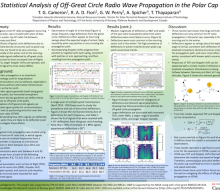Statistical Analysis of Off-Great Circle Radio Wave Propagation in the Polar Cap
Taylor G.
Cameron
Canadian Hazards Information Service, Natural Resources Canada
Poster
High Frequency radio waves propagating in the polar cap are often deflected to off-great circle paths by localized ionospheric electron density structures such as polar cap patches and arcs. These off-great circle deflections can reduce signal quality for communications, and lead to large errors in positioning for over-the-horizon radar. In this study, nearly 2.5 years of multi-frequency transmissions from Qaanaaq, Greenland to Alert, Canada are used to perform a statistical analysis of the occurrence and impacts of off-great circle propagation in the polar cap. Off-great circle deflections are shown to be very common in the polar cap. For example, averaged over one year, 11.1 MHz signals experienced deflections > 30 degrees from the great circle direction 70.7% of the time. The occurrence of off-great circle deflections is shown to be at a maximum in the winter and close to zero in summer, and higher in the morning sector than the evening sector for frequencies < 14.4 MHz. A comparison of the angle of arrival of signals with relevant signal parameters shows that off-great circle deflections are associated with increased time-of-flights, a larger range of possible Doppler shifts, increased Doppler spreads, and lower signal-to-noise ratios. These results are discussed and explained in the context of space weather-related ionospheric phenomena in the polar cap. Implications for over-the-horizon radar operation at high latitudes are also discussed.

Poster PDF
Poster category
Ionosphere and Thermosphere Research and Applications
Meeting homepage